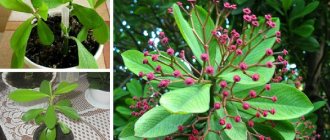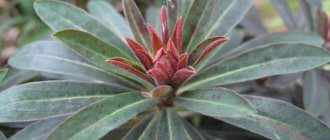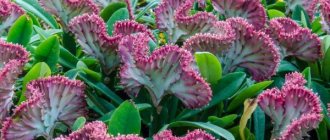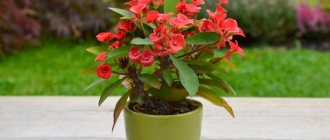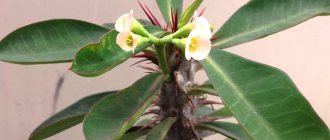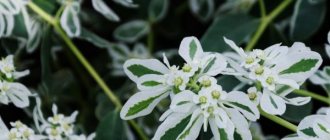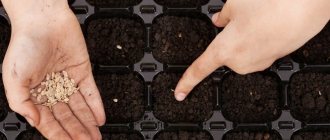Euphorbia triangularis is a succulent with a triangular stem and small leaves. It is often confused with a cactus due to its appearance. In common parlance it is often called the Mexican cactus. It looks spectacular and even for weeks, without the care it needs, the succulent does not lose its decorative appearance. In nature, triangular spurge grows in harsh environments where it receives few nutrients.
Brief description of Euphorbia triangularis
The African subtropics and Madagascar are considered the homeland of this plant. It is not a cactus, although it looks similar to them. This is a succulent of the Euphorbiaceae genus with a fleshy ribbed trunk studded with spines. The plant is large; in nature it grows to the size of a tree (about six to eight meters). You can find such names for succulents as exo cactus or Mexican cactus.
At home, it stretches only two to three meters and branches heavily. Its stems have a bright green tint. They are dotted with oblong leaves about two to three centimeters long. Typically the leaves are located towards the top of the milkweed. The leaves quickly fall off and new ones grow in their place. This succulent does not form buds or bloom, but it grows quickly. It is often found in offices, on terraces and balconies.
Is it possible to grow it in an apartment or house? It can be planted at home, but should be handled with care. If the juice splashes on the skin, wash it off with water. It is not recommended to plant it in apartments where there are pets or children. You should not place it in the bedroom, because the aroma of a succulent has a negative effect on the nervous system and provokes lack of sleep.
Flower growers make the mistake of attributing to it the same properties as cacti, placing the pot near the computer. It does not absorb harmful radiation. The succulent is not related to cacti.
Characteristics and description
Euphorbia triangular, triangular or euphorbia trigona, and in Latin Euphorbia trigona - these are all the names of one of the most striking representatives of succulents of the Euphorbia family.
This is a large plant with a thick and fleshy stem, distinguished by three sides and clearly defined ribs with small spines. Small oblong leaves grow on the tops of the stems. This milkweed is often confused with the cactus , to which it has no relation.
The homeland of the exotic succulent is the island
of Madagascar and the subtropics of Africa, where it grows in the form of tall, exotic trees on dry hills.
Is it possible to keep Euphorbia triangularis at home?
In indoor conditions, euphorbia also does not hesitate to grow, reaching 3 meters in height or even more if the ceiling height allows.
Euphorbia triangular branches well, over time acquiring numerous shoots.
In its prime, having reached an impressive size, it resembles an unprecedented candelabra with green triangular candles. There is also an interesting variety with a reddish stem and dark crimson leaves, but it is very rare in flower collections.
Grown as an indoor flower, triangular euphorbia does not bloom , but attracts gardeners with its extraordinary decorativeness. Rarely is an office complete without the exotic beauty of this plant. After all, it is unpretentious and long-lived , maintaining its impressive appearance for many, many years.
The following types of Euphorbia are extremely popular in home cultivation: Multi-flowered, Bordered, Cypress, Tirukalli, Ribbed, Pallas, White-leafed, Mila.
Useful and harmful properties
An unpleasant discovery for many gardeners is poisonous milky sap. But the plant is quite useful, apart from this small drawback.
It helps purify the air in the room and kills harmful microorganisms. The plant is often used to treat skin growths such as warts, corns and calluses. They can destroy parasites and be used to treat other pathologies. Indian healers crushed euphorbia and covered wound surfaces with powder after snake bites. When collecting sap, people wrapped a rag around their face to avoid inhaling the droplets and burning their skin.
In case of contact with the skin, blisters may swell, the skin may turn red, and itching may occur. If this happens, the skin is washed and the affected area is lubricated with a cream containing glucocorticoids. If the juice gets inside, the tongue may become numb, diarrhea may develop, and the person may feel nauseous and vomit. If it gets into your eyes, you can even go blind.
Popular: Growing Pereskia Succulent with Citrus Scent
Benefits and harms
The plant is considered poisonous, which must be taken into account if there are children or animals in the family.
Beneficial features
Euphorbia purifies the air and fights harmful bacteria. Many people place the flower near the computer in order to minimize the negative impact of electromagnetic waves, mistakenly confusing it with a cactus. It won’t cope with such an impact, but it will set you up for productive work.
It is not worth keeping a pot with a majestic beauty in the bedroom, which is due to the subtle aroma of the plant. As a result, irritability and sleep disturbance may occur.
In ancient times, it was used to reduce warts, calluses and various diseases. Indian healers used powder from the root of the succulent as an antidote for snake bites.
True, modern doctors are ardent opponents of this technique. Despite the experience of our ancestors, they note the toxicity of the culture.
When interacting with the skin, milky juice can provoke severe irritation, and even a small drop of milk that gets on the tongue causes numbness.
Before pruning or replanting milkweed, you should stock up on protective gloves, and wash your hands thoroughly with soap after the procedure.
How to care for milkweed
This plant can be considered a gift for inexperienced gardeners because it can survive in almost any conditions and easily tolerates being forgotten about for a week or two. He can put up with a lack of sunlight, infrequent watering and placement near radiators. But the better its maintenance conditions and care, the faster the plant will stretch and develop. Like all euphorbias, it is poisonous, so caring procedures are carried out only with gloves. You should not allow poisonous milk to come into contact with your skin.
Landing location and temperature
Mexican cactus can be grown both in shaded areas and in a sunny corner of the room. It is recommended to place it in a place convenient for the owner: on a windowsill, near a radiator, in the shade. You can place the succulent on the balcony, terrace, or winter garden. When you decide to place a pot with a plant in the bright sun, you should remember that the succulent should get used to it gradually. Otherwise, it gets burned.
During the period of active growth, the plant is not picky about temperature. And in the winter months, the room should be a little cooler, for example, from 15 to 18 degrees.
Watering regime for milkweed
When a succulent enters its growing season and is growing rapidly, it needs to be watered constantly. Usually, watering once every seven days is sufficient, but the earthen ball should not be allowed to dry out.
In the winter months, the amount of watering is reduced. If the room is cool, then the amount of watering is completely minimized. The plant easily tolerates drought and moisture deficiency, but it does not like to be flooded; if moisture stagnates in the container, the roots can rot.
For a succulent, it doesn’t matter how humid the air in the room is, but it needs a shower and spraying. Thanks to these procedures, it acquires a decorative appearance. During a shower, cover the soil in the container with film to prevent drops of water from falling on it. In addition, one of the hygienic procedures for caring for it will be cleaning the trunks from dust.
The soil
For triangular milkweed, loose soil through which water flows well is best. A drainage layer should be placed at the bottom of the pot. For planting, you can use ready-made soil purchased at the store. It is also possible to independently prepare soil from peat, leaf soil, and turf. These ingredients are mixed in equal proportions. Drainage made of brick chips is laid at the bottom of the container.
Popular: Light-loving succulent guernia with an unpleasant odor
What does triangular spurge look like, what family does it belong to?
This is a stem succulent with three sides, its second name is Euphorbia trigona (in Latin), from the Euphorbiaceae family. The culture is popularly called exocactus or Mexican cactus due to the external similarity of the plants.
Exotic plant Euphorbia triangularis
Euphorbia triangular branched, it has many side shoots. The culture resembles a candelabra with candles, grows quickly, reaches several meters in height, but has a shallow root system. Taking these features into account, it is tied up, having previously installed a support, or planted in a deep pot with drainage and placed only in spacious rooms.
The fleshy stems of triangular milkweed are covered with numerous brown spines; on their tops there are oblong leaves about 3-5 cm long. The color of the stems and leaves is dark green. There are unusual specimens with pink stems and red or purple leaves. The trunk diameter is 6 cm. Flowering occurs mainly in natural growing conditions; indoor crops rarely bloom.
Important! The leaves and stems of the plant contain poison in the form of milky sap, so care for it is carried out using gloves. After contact of the skin and mucous membranes with euphorbin, irritation appears and a burn is possible. If the juice gets into the eyes, blindness may develop. When a toxic substance enters the digestive tract, severe poisoning of the body occurs.
Common varieties
Euphorbia triangular can be selected for any interior. The most common indoor varieties include Suzanne, Mix, Gabizan, Rubra and Decarie. The Rubra (Royal) variety is distinguished by dark red leaves, the presence of this feature is due to a change in DNA.
Rare variety - Euphorbia Rubra
On a note! Hybrids have been bred that can withstand low temperatures (up to 0 °C).
All succulents of the Euphorbiaceae family are rare species. This is an endangered plant in the wild.
Medicinal properties
Leaves, roots, stems and juice are used for treatment. Euphorbia is an effective remedy for hemorrhoids and cystitis; it can be used to get rid of tumor formations, tuberculosis, influenza, and colds.
The plant is effective in the treatment of age spots and warts, skin diseases (fungus, eczema, lichen, burns, non-healing ulcers). You can take a bath with the addition of infusion or be treated with the milky juice of milkweed.
Additional Information. In India, the dried root is ground into powder and used as a medicine for snake bites. Decoctions are also prepared from the roots and leaves. The juice has an anti-inflammatory, laxative, diaphoretic, and diuretic effect on the body. It is added to pharmaceuticals and homemade alcohol tinctures.
For diseases of the liver and stomach, a diluted decoction of the root is taken orally. Migraines are treated with tinctures based on the roots. The use of triangular euphorbia is contraindicated in childhood, during the period of bearing and feeding a child, in case of serious pathologies of the cardiovascular system.
Briefly about the history of appearance
In the 54th century BC. e. The culture was named Euphorbia in honor of the court healer Ephorbus, because it was he who managed to find out what medicinal properties it has. The plant can be found on the island of Madagascar and in Central America. Cactus in a pot, Euphorbia triangularis, is an African guest, common in three climatic zones (subtropical, temperate, tropical).
Euphorbia in its natural environment
How does the transplant take place?
The new pot must be selected according to the size of the succulent, and it should not be too deep, because the root system of milkweed does not lie too deep. For large euphorbias, stones are placed at the bottom so that the plant does not fall along with the pot under its own weight. Drainage at the bottom of the container is mandatory.
After the milkweed has been purchased, it is necessary to inspect it for diseases and insects and rinse it in the shower. After purchase, the plant should be given 7–14 days to adapt, removed from other plants. Then you need to perform a transplant by transshipment. The roots need to be cleared of old soil.
Young plants should be repotted every 12 months, while older succulents can be replanted in a new pot every two to three years. Typically, adult plants are transplanted when there is no more room for the roots in the old container. Every spring it is better to remove the top layer in the pot and replace it with new soil.
Plant nutrition
Euphorbia triangularis should be fertilized from the spring months through the fall. You can use a special composition designed for succulents. The mixture already includes the entire set of necessary microelements.
What types are there?
Euphorbia is a numerous genus of plants in the Euphorbiaceae family . There are a huge number of species, among which there are both annual and perennial. This genus also includes representatives of different groups:
- succulents;
- herbs;
- shrubs;
- trees.
Moreover, they can be deciduous, leafless, prickly, or have different stems that are different from each other. The only thing that unites representatives of the Euphorbia genus is the presence of white juice, reminiscent of milk.
The sap of any type of milkweed is poisonous, so it is not a suitable plant for apartments with pets and children. You should also be careful when using folk recipes with milkweed: it can only be used externally.
Description of varieties
Indoor spurge has many different species, different from each other . Most often, several of them are grown at home.
Triangular
One of the tallest types of indoor milkweed - it can reach 1 m in height, however, it is most often grown on window sills. A young plant has one trunk, but the older it is, the more branches it has. It has double spines on the tubercles and flattened leaves on thin branches, which is why it looks somewhat strange.
Video about milkweed triangular:
Poinsettia
Also called Euphorbia Beautiful . It is a tall branched bush with many thin stems. The leaves are large (up to 16 cm), oval, but pointed at the ends. Their surface is ribbed, rough, with obvious veins. The bracts are large and red, the flowers are also red and resemble ordinary leaves.
Poinsettia is considered one of the most beautiful species of milkweed.
Video about Euphorbia Poinsettia:
mile
He's a brilliant spurge . It is a highly branching succulent with elliptical leaves and many thick conical needles. It can bloom, the flowers are yellow, orange, white, pink, etc.
Video about milkweed Mil:
Belozhilkovy
It has a single trunk, woody closer to the roots. The leaves are oval, but pointed towards the end, growing on fleshy, succulent branches. Arranged in a spiral. Over time, they die and fall off from the bottom up, with the result that over time the plant resembles a small palm tree, since the foliage remains only at the top. The leaves themselves are dark green with white veins, their reverse side is pale. Doesn't bloom.
Video about Euphorbia Belozhilkov:
Enopla
A highly branching succulent that, under favorable conditions, can grow up to 1 m in height. It has long (about 5 cm) spines, red in a young plant and turning gray in old age.
Pruning a succulent
It is not necessary to prune the plant. So, it quickly stretches out and looks like a tree decorating the room. If the area does not allow, then you can trim it as soon as it reaches the height desired by the gardener.
The tops of its trunks need to be cut off with a sharp knife and the resulting sections sprinkled with crushed charcoal. This procedure will speed up the development of new stems and give the plant the desired shape. After pruning, the bush becomes less loose. If the gardener does not want to prune the succulent, then you can cover its top with a bottle cap and the side trunks will begin to develop.
Dividing a bush at home
Euphorbia can be propagated by dividing the root part of the bush.
Pros and cons of the method
This method has its negative and positive aspects.
pros:
- the plant grows faster than from seeds or rooted cuttings;
- plants from the root grow stronger and healthier.
Minuses:
- the possibility of infection of each new part of the plant with diseases if the adult succulent was sick;
- there is a high risk of new ground shoots not appearing; in this case, the root simply disappears in the soil.
Preparatory stage
To prepare a root seedling, you need to proceed in the following order:
- choose a healthy adult plant for division;
- remove the entire plant from its original pot;
- remove the entire ground part;
- Gently rinse the root part with filtered water;
- Use a sharp knife to divide the roots of the bush into parts, each part should have a sprout or bud;
- Dry the cut with coal or wood ash.
Algorithm of actions
In order for new root seedlings to take root and grow, you need:
- treat each separated root part of the plant with a special product - Kornevin;
- prepare a pot with drainage and soil;
- moisten the soil;
- plant a root seedling;
- Be sure to lightly press the soil around the new plant.
Propagation of milkweed: cuttings
Triangular spurge propagates using lateral layering. Their length must be at least ten centimeters. It is best to prepare planting material in the spring. Layers are rooted in soil consisting of sand and peat. They are mixed in a 1:1 ratio. The cut areas should be washed under the tap so that the poisonous juice of the plant stops secreting. After this, the sections need to be sprinkled with crushed coal powder.
Popular: Care and flowering of succulent faucaria of the Aizov family
Then the cuttings must dry for some time so that a film forms on them. The cuttings are planted in the substrate and covered with film to create greenhouse conditions for them. Until the root system is formed, they should be watered and ventilated regularly to prevent them from rotting.
Seeds
This method is not used by gardeners at home. Hybrid varieties do not flower or produce seeds. Propagation by seeds is possible only in laboratory conditions. Planting material is sown in the spring months. Seeds are planted in moist soil at intervals of 20 centimeters; they should not be buried more than two centimeters. They begin to sprout 14 days after they were planted. Plants quickly take root at temperatures of at least 20 degrees.
Dividing the bush
In spring, the plant can be propagated by dividing the stems. In this case, the bush is divided so that each part has a root. The division procedure is carried out as follows: the soil in the pot is watered, after which the plant is taken out and the “dead shoots” are cut off. The succulent is divided into several parts and planted in different containers. Each young plant should be watered moderately, and the temperature in the room should not fall below 20 degrees.
Possible problems in cultivation and diseases
Many problems associated with growing crops arise due to improper care. The risk of pest damage in this case also increases.
The plant sheds its leaves
When the soil is constantly waterlogged, moisture stagnates. There is a risk of root rot and leaf fall. The same problem can occur if there is poor drainage and infection of the cut areas. To save the plant, it is replanted. For preventive purposes, fungicides are used.
The leaves are turning pale
If Euphorbia triangular does not have enough nutrients, or their supply is excessive, the leaves may lighten. To solve the problem, it is enough to adjust the feeding regime.
The tips of the leaves are drying out
When the plant is exposed to direct sunlight for a long time, areas of brown color appear on the surface of the leaves. The problem is eliminated by changing the lighting level.
Euphorbia after exposure to direct sunlight
Pests
Euphorbia triangularis can be affected by mealybugs. In this case, the upper part of the bush becomes covered with a white coating. Red spider mite infestation is determined by the web on the leaves. Aphids are also not afraid of poisonous sap; it repels other pests.
Other signs of damage to milkweed triangular by pests include slow growth, stickiness, and minor damage to the trunk. The problem is solved by using insecticides and acaricides. If there are a lot of insects, a single treatment is not enough; there should be at least 3 of them with an interval of 10 days.
Other problems
After prolonged waterlogging, the plant stems become covered with spots. If the pot is not suitable, growth will slow down. When the milkweed does not receive enough natural light, the stems become noticeably elongated.
Note! Most problems can be solved with proper care, others can be eliminated with chemicals.
Diseases
Euphorbia triangularis is rarely affected by insects due to its toxicity. But spider mites can weave webs on its stems and leaves. Sometimes aphids attach themselves to the plant or it is affected by mealybugs. When infected with a mealybug, a white coating appears on the leaves. The plant should be inspected from time to time, and if it is damaged by insects, insecticides should be applied. It is possible to treat succulents using traditional methods.
If properly cared for, this plant rarely gets sick, but if the soil is too wet, it may drop its leaves. If the Mexican cactus is not fed, its foliage turns yellow. Brown burns may appear on the stems and leaves if the plants are burned by the sun's rays. There are many signs associated with milkweed; for example, it is believed that its thorns scare away gossip and negative emotions from the home.
Currently reading:
- Types and cultivation of poisonous milkweed Tirukalli
- Increased potato yield using Dutch technology
- How to grow Chinese cabbage in open ground
- Tips for keeping poinsettias at home
Share the news on social networks
About the author: Lyudmila Vasilievna Nosikova
Agronomist of the state agricultural enterprise "Garovskoe" of the Khabarovsk region of the Khabarovsk Territory.
Features of care in winter, rest period
Euphorbia fringed - care features
In winter, plants are provided with rest. Euphorbia trihedral does not require care at home during this period; it is enough to leave it in a cool room. Euphorbia is watered when the soil has dried 3 cm.
In winter, the stems do not lose their decorative appearance, but the milkweed almost does not grow. From the second half of October, every day from 6 pm to 8 am, it is recommended to keep the pots in the dark. You can cover plants with materials that do not allow light to pass through.
Signs and superstitions
If we rely on signs and superstitions, then there is no definite opinion whether it is possible to keep Euphorbia Trigon at home. According to some sources, the plant brings negativity into a person’s life. Many people believe that culture should not be placed in the recreation area or bedroom, which is especially true for married couples. This is due to the presence of thorns, which symbolize tension in relationships.
Others, on the contrary, assure that this flower has a positive effect on energy flow. Thanks to its life-giving power, the home bush is able to give peace and spirituality to all household members, as well as solve problems with the musculoskeletal system.
You can grow succulents in the office without fear. According to beliefs, it will bring good luck to its owner, success in career growth and a positive attitude towards colleagues.
